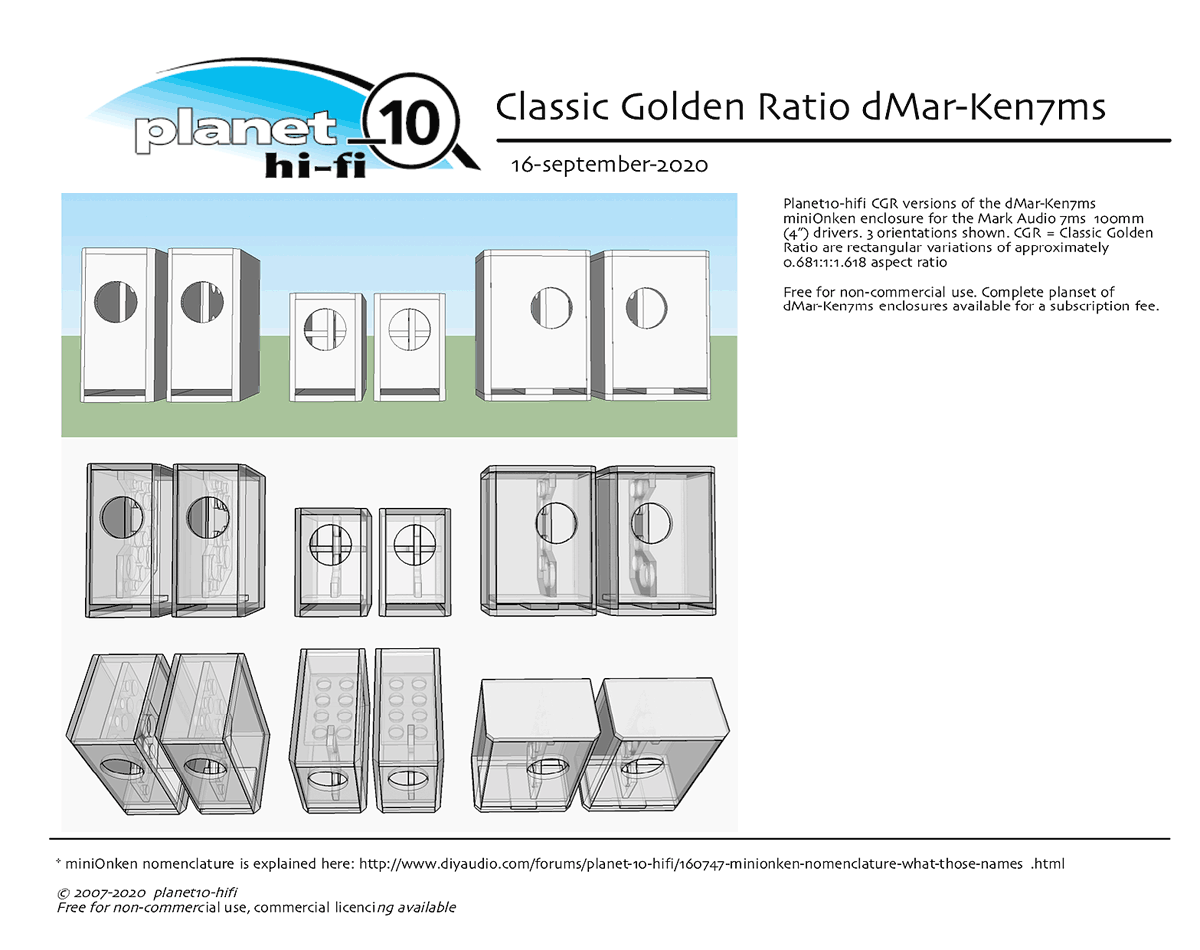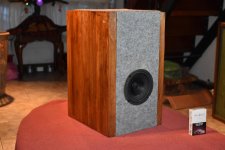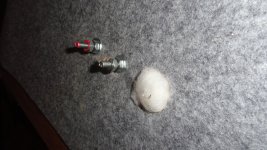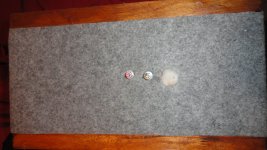I have a good friend wanting some new bookshelf speakers. He appreciates good sound, but he primarily listens to 80's punk rock so we're not talking about bass or good recordings. He will listen to folk and other stuff occasionally, but is not an audiophile in the sense of demanding the best from his gear. These will be for bedroom/small room listening, max 10 feet away and likely placed on a shelf close to a wall.
I'm thinking something up to maybe 5" size and a potentially one of the BabyLab cabinets. Is there a reasonably priced driver with decent performance in this size? I'd like to keep cost under $100usd not including the wood for the pair.
I'm thinking something up to maybe 5" size and a potentially one of the BabyLab cabinets. Is there a reasonably priced driver with decent performance in this size? I'd like to keep cost under $100usd not including the wood for the pair.
The SBA SB10PGC21-4 is a very good and balanced driver. It has a slight distortion peak at 4kHz, but it doesn’t seem to bother anyone that has it.
The TC9FD-8 is also very good and balanced, but the SBA is better.
A 5 » driver will beam a lot. I have a couple of TB at that size and they would need a tweeter. Plus, they always need a notch or two to perform their best.
The TC9FD-8 is also very good and balanced, but the SBA is better.
A 5 » driver will beam a lot. I have a couple of TB at that size and they would need a tweeter. Plus, they always need a notch or two to perform their best.
What about an SB13PFC (5") coaxial driver, SB Acoustics even supply you with the crossover schematic and cabinet details. Around A$70, I think.
Geoff
Geoff
Markaudio CHN-110 is really close to your budget and a really good driver for the money. Bix won;t be real small.
At the other end size wise would be Alpair 5.3, the CHN-50 the budget vesion (2 per box?).
In the moddle (5-9 litres) would be P7HD or CHR-70. I figure teh P7 best value of the 2.
dave
At the other end size wise would be Alpair 5.3, the CHN-50 the budget vesion (2 per box?).
In the moddle (5-9 litres) would be P7HD or CHR-70. I figure teh P7 best value of the 2.
dave
I'll offer up my choice...the NOS RadioShack five-inch Realistic driver with the appropriate sized enclosure. They are still available as NOS, cat # 40-1284(E). Mine sounds great, ...just now looked them up & Ebay has them for $18 each.
After lots of research, a seventeen liter enclosure with a one-inch hole bored into the back & overstuffed with cotton batting to work in an Aperiodic alignment works fine.
The Mark Audio CHR-70 while marketed as a "Four-inch" driver...as in actuality a cheap plastic three-inch driver, the giant mounting flanges on MA gear is a source of marketing deception. Only recently "they" noted the cone sizes as measured in millimeters. As I have been "making noise" about this practice for awhile ...lots of frame & little actual moving cone...perhaps they slid in that notation of actual cone size & I didn't notice.
As with any of these small drivers & their low sensitivity (84-89) Db...they gobble up wattage...the power levels that would make your "big speakers" stand up & shout...these little guys are so very low in volume. Running 1 1/2 times their rated power is enough to make them shine....but watch & listen for rattling cones & keep your nose at the ready for burnt voice-coils.
----------------------------------------------------------------------------------------------------------------------------------------------------------------------------------Rick...
After lots of research, a seventeen liter enclosure with a one-inch hole bored into the back & overstuffed with cotton batting to work in an Aperiodic alignment works fine.
The Mark Audio CHR-70 while marketed as a "Four-inch" driver...as in actuality a cheap plastic three-inch driver, the giant mounting flanges on MA gear is a source of marketing deception. Only recently "they" noted the cone sizes as measured in millimeters. As I have been "making noise" about this practice for awhile ...lots of frame & little actual moving cone...perhaps they slid in that notation of actual cone size & I didn't notice.
As with any of these small drivers & their low sensitivity (84-89) Db...they gobble up wattage...the power levels that would make your "big speakers" stand up & shout...these little guys are so very low in volume. Running 1 1/2 times their rated power is enough to make them shine....but watch & listen for rattling cones & keep your nose at the ready for burnt voice-coils.
----------------------------------------------------------------------------------------------------------------------------------------------------------------------------------Rick...
Attachments
Rick, those are interesting and certainly cheap enough to play around with. I may just pick up a set for some old Dual bookshelf speakers I have with a blown driver. Might make for a good shop system speaker!
As I am unable to grasp mentally box sizes in liters, roughly what are your dimensions?
As I am unable to grasp mentally box sizes in liters, roughly what are your dimensions?
Complete and utter nonsense.the giant mounting flanges on MA gear is a source of marketing deception.
jeff
The Mark Audio CHR-70 while marketed as a "Four-inch" driver...as in actuality a cheap plastic three-inch driver, the giant mounting flanges on MA gear is a source of marketing deception.
For the sake of interest:
-Yes, it's an inexpensive driver. It's part of the entry-level range, so being inexpensive is something of a requirement.
-The basket is a reinforced polymer (fibreglass reinforced plastic variation) and always has been. Being a polymer, it provides greater self-damping than alloy or stamped steel, but needs to be physically larger to provide the necessary rigidity. No mystery about that, just basic mechanical engineering.
-Most people tend to use Sd as a functional criteria. The rest are simply informally established nominals used for convenience. The vast majority of drive units, irrespective of type, described as '4in' have an Sd of around 50cm^2, give or take roughly 10%. If basket diameter is the metric then most would be rated at a larger size -in Imperial, likely 4.75in - 5in, as Dayton for e.g. do, or if they use metric, roughly 120mm - 125mm as, for e.g., Seas and Scan do.
In fairness, since it's always been noted, with the dimensions and T/S data supplied, that's hardly the fault of the manufacturer.Only recently "they" noted the cone sizes as measured in millimeters.
Now, the old RS drivers -some could be very good for the money, I agree. It would be nice to see somebody bring the better ones back. We can but hope.
Away from MA, Tang Band's W5-1611 isn't too bad, although whether the budget could swing that far I don't know. Possibly worth considering. The old Goldwood B20 may be worth a look too, albeit larger than mentioned, & it's apparently not as consistent as the original Pioneer-built units. Still, for the price...
Last edited:
really cheap 4 inch "midbass" used as fullrange:
https://www.donhighend.de/?page_id=6894 (german site)
https://www-donhighend-de.translate..._sl=de&_x_tr_tl=en&_x_tr_hl=de&_x_tr_pto=wapp (translated version)
not sure whether the monacor-driver is easily available in the US ... available for around 15 EUR in europe.
https://www.donhighend.de/?page_id=6894 (german site)
https://www-donhighend-de.translate..._sl=de&_x_tr_tl=en&_x_tr_hl=de&_x_tr_pto=wapp (translated version)
not sure whether the monacor-driver is easily available in the US ... available for around 15 EUR in europe.
Tang Band's W5-1611 isn't too bad
Has really good bass but the top is kinda plasticy sounding.
dave
The outside dimensions as pictured, 243mm wide, 282mm deep, 420mm high. Now of course one needs to take the thickness of the wood itself into account...in my case, the outer "butcher-block", pretty looking stuff is kinda thick at 28mm...the stuff hidden under my...poorly executed carpeting grey stuff was thinner at 5/8 inch MDF. My reasoning was that smaller run of 243mm worth, minus 28mm & 28mm could stand to be a bit thinner. The thicker butcher block was the only "dressy" looking stuff I could find.Rick, those are interesting and certainly cheap enough to play around with. I may just pick up a set for some old Dual bookshelf speakers I have with a blown driver. Might make for a good shop system speaker!
As I am unable to grasp mentally box sizes in liters, roughly what are your dimensions?
Are you familiar with the math concept of Cube Root? In my case, I concluded after the research I was to be shooting for 17 liters...the cube root of 17 is 2.57128159...so a perfect cube of 257.12mm per side will get me a seventeen liter volume...Now of course I don't want just a cube, so I used a suitable ratio, such as the common 0.618 by 1.0 by 1.618.
--------------------------------------------------------------------------------------------------------------------------------------------------Rick...
Are you familiar with the math concept of Cube Root? In my case, I concluded after the research I was to be shooting for 17 liters...the cube root of 17 is 2.57128159...so a perfect cube of 257.12mm per side will get me a seventeen liter volume...Now of course I don't want just a cube, so I used a suitable ratio, such as the common 0.618 by 1.0 by 1.618.
exactly how i start when determining the starting place for my Classic Golden Ratio miniOnkens. Justa start as the thickness of teh wood and the slot vent at the bottom make for some paffing about.

dave
The outside dimensions as pictured, 243mm wide, 282mm deep, 420mm high. Now of course one needs to take the thickness of the wood itself into account...in my case, the outer "butcher-block", pretty looking stuff is kinda thick at 28mm...the stuff hidden under my...poorly executed carpeting grey stuff was thinner at 5/8 inch MDF. My reasoning was that smaller run of 243mm worth, minus 28mm & 28mm could stand to be a bit thinner. The thicker butcher block was the only "dressy" looking stuff I could find.
Are you familiar with the math concept of Cube Root? In my case, I concluded after the research I was to be shooting for 17 liters...the cube root of 17 is 2.57128159...so a perfect cube of 257.12mm per side will get me a seventeen liter volume...Now of course I don't want just a cube, so I used a suitable ratio, such as the common 0.618 by 1.0 by 1.618.
--------------------------------------------------------------------------------------------------------------------------------------------------Rick...
Excellent, thank you. I am familiar with the math, just im in the US and can't readily visualize something in liters as easily. I build custom aquariums, so I typically work in gallons or ft^3 and know roughly how big something is based on those dimensions. I was also a few beers in sitting at the computer when I typed that, lol!
1 cubic foot is approx. 28 liters. 1 liter is approx. 61 cubic inches.I build custom aquariums, so I typically work in gallons or ft^3
What's an average custom aquarium size? (just curious)
jeff
Last edited:
I cringe to think of the weight of one of those "nice" aquariums....I wonder how many "customers" of those custom sizes react when you tell them the calculated weight....& the recommended "rebuilding" of platforms because of the weight.
-----------------------------------------------------------------------------------------------------------------------------------------------Rick...
-----------------------------------------------------------------------------------------------------------------------------------------------Rick...
Basic rule of thumb, 10lbs per gallon set up. Big tanks may require rebuilding floors in houses.
So for a 17L box, I'm looking at around 4.4 gallons which is conveniently just about 1024in^3. (231in^3 per gallon) Thats an easy number for me to workout ratios and sizing with. I may just slap together an acrylic box from scraps and order some of those RS drivers.
So for a 17L box, I'm looking at around 4.4 gallons which is conveniently just about 1024in^3. (231in^3 per gallon) Thats an easy number for me to workout ratios and sizing with. I may just slap together an acrylic box from scraps and order some of those RS drivers.
visualize something in liters
7 litre = 0.25 ft3
28 litre = 1 ft3
dave
Remember to create a one-inch hole at the back & extend the stuffing thru the hole as to make for a "resistive vent", the aperiodic alignment.
------------------------------------------------------------------------------------------------------------------------------------------------------------------Rick...
------------------------------------------------------------------------------------------------------------------------------------------------------------------Rick...
Attachments
- Home
- Loudspeakers
- Full Range
- Looking for a cheap driver for bookshelf speakers


